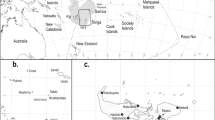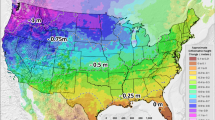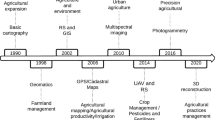Abstract
Defining the spatial extent of mountain areas has long been a challenge. In the present century, the availability of digital elevation models (DEMs) incorporated into geographic information systems (GIS) has allowed the definition of mountain areas based on topographic and other criteria. This paper presents the various delineations of mountains that have been prepared at three scales – global, regional (Europe), and national – and explores the reasons and processes leading to these delineations, and how they have been used. A detailed case study is then presented for Norway. Overall, two types of approaches to mapping mountains have been taken: first, considering mountains per se, based on elevation and/or topography; second, considering them among other categories, e.g., landforms or biogeographical, environmental or landscape zones. All attempts to map mountain areas derive essentially from the objectives of those commissioning and/or undertaking the work; a unitary definition remains unlikely.
Article PDF
Similar content being viewed by others
Change history
13 June 2018
The article Mapping mountain areas: learning from Global, European and Norwegian perspectives, written by Martin F. PRICE, Tor ARNESEN, Erik GLØERSEN and Marc J. METZGER, was originally erroneously published electronically on the publisher’s internet portal (currently SpringerLink) on May 21st 2018 without open access.
When the mistake was discovered the copyright of the article changed in June 2018 to © The Author(s) 2018 and the article is forthwith distributed under the terms of the Creative Commons Attribution 4.0 International License (http://creativecommons.org/licenses/by/4.0/), which permits use, duplication, adaptation, distribution and reproduction in any medium or format, as long as you give appropriate credit to the original author(s) and the source, provide a link to the Creative Commons license, and indicate if changes were made. The original article has been corrected.
References
Arnesen T (1998) Landscapes lost. Landscape Research 23(1): 39–50.
Arnesen T (1999) The hydropower policy evolution, planning and decision making in Norway in 20th century with a reference to the G&L–basin. In: Norwegian Institute for Nature Research and Eastern Norway Research Institute, The Glomma and Laagen Basin, Norway: A case study prepared as an input to the World Commission on Dams, Cape Town. pp 81–113.
Arnesen T, Ericsson B (2013) Policy responses to the evolution in leisure housing: From the plain cabin to the high standard second home. The Norwegian case. In: Roca IZ (ed.), Second Home Tourism in Europe: Lifestyle Issues and Policy Responses. Ashgate, Farnham. pp 285–308.
Arnesen T, Overvåg K, Gløersen E, Schurman C, Riise Ø (2010) Fjellområder og fjellkommuner i Sør–Norge. Definisjon, avgrensing og karakterisering [Mountain areas and mountain communes in South Norway. Definition, delineation and characterisation]. Report 08/2010 Lillehammer: Østlands forskning.
Ariza C, Maselli D, Kohler T (2013) Mountains: Our Life, Our Future. Progress and Perspectives on Sustainable Mountain Development from Rio 1992 to Rio 2012 and Beyond. Bern: Swiss Agency for Development and Cooperation and Centre for Development and Environment.
Balsiger J (2016) The European Union Strategy for the Alpine Region. In: Gãnzle S, Kern K (eds.), A Macro–regional Europe in the Making: Theoretical Approaches and Empirical Evidence. Palgrave Macmillan, New York. pp 189–213.
BISE (2015) Map of European Ecosystems. (http://biodiversity.europa.eu/maes/mappingecosystems/map-of-european-ecosystem-types, accessed on 2018-02-19).
Blyth S, Groombridge B, Lysenko I, et al. (2002) Mountain Watch: Environmental Change and Sustainable Development in Mountains. Cambridge: UNEP World Conservation Monitoring Centre.
Browne T, Fox R, Funnell D (2004) The “invisible” mountains: Using GIS to examine the extent of mountain terrain in South Africa. Mountain Research and Development 24: 28–34.
Bunazzo M (2016) The history and evolution of cohesion policy. In: Piattoni S, Polverari L (eds.), Handbook on Cohesion Policy in the EU. Edward Elgar, Cheltenham. pp 17–35.
Byers AC, Price LW, Price MF (2013) An introduction to mountains. In: Mountain Geography: Physical and Human Dimensions. Berkeley: University of California Press. pp 1–10.
Castelein A, Dinh TTV, Mekouar MA, Villeneuve A (2006) Mountains and the Law: Emerging Trends. FAO Legislative Study, Rev. 1. Rome: Food and Agriculture Organization of the United Nations.
Cheng WM, Zhou CH, Chai HX, et al. (2011) Research and compilation of the geomorphologic atlas of the People’s Republic of China (1:1,000,000). Journal of Geographical Sciences 21(1): 89–100. https://doi.org/10.1007/s11442-011-0831-z
Cheng WM, Liu Q, Zhao S, et al. (2017) Research and perspectives on geomorphology in China: Four decades in retrospect. Journal of Geographical Sciences 27(11): 1283–1310. https://doi.org/10.1007/s11442-017-1436-y
Coenen F, Norland I, Bjornaes T (2003) Local Agenda 21 in the Nordic Countries–national strategies and local status (Report No. 1/03). Oslo: ProSus–Senter for utvikling og miljø–University of Oslo.
Debarbieux B, Balsiger B, Djordjevic D, et al. (2014) Scientific collectives in region–building processes. Environmental Science and Policy. https://doi.org/10.1016/j.envsci.2014.06.005
Debarbieux B, Delannoy JJ, Dobremez JF (2000) Les pays du monde et leurs montagnes [The countries of the world and their mountains]. Grenoble: Editions Revue de Géographie Alpine.
Debarbieux B, Price MF (2008) Representing mountains: From local and national to global common good. Geopolitics 13: 148–168.
Debarbieux B, Price MF, Balsiger J (2013) The institutionalization of mountain regions in Europe. Regional Studies. https://doi.org/10.1080/00343404.2013.812784
Debarbieux B, Rudaz G (2015) The Mountain: A Political History from the Enlightenment to the Present. Chicago: University of Chicago Press.
Di Filippo A, Biondi F, Cufar K, et al. (2007) Bioclimatology of beech (Fagus sylvatica L.) in the Eastern Alps: spatial and altitudinal climatic signals identified through a tree–ring network. Journal of Biogeography 34: 1873–1892.
Dijkstra L, Poelman H (2011) Regional Typologies: A Compilation. Regional Focus 01/2011. Brussels: Directorate–General for Regional Policy, European Commission.
Direktoratet for naturforvaltning (2011) Veileder. Metode for landskapsanalyse i kommuneplan [Guide. Method of landscape analysis in the municipal plan]. Trondheim: Direktoratet for naturforvaltning [Norwegian Environment Agency].
Eckerberg K, Coenen F, Lafferty WM (1999) The Status of LA21 in Europe: a comparative overview. In: Lafferty WM (ed.), Implementing LA21 in Europe: New Initiatives for Sustainable Communities. ProSus, Oslo. pp 241–261.
ESPON (2017) Revealing territorial potentials and shaping new policies in specific types of territories in Europe: islands, mountains, sparsely populated and coastal regions. ESPON Working Paper. Luxembourg: ESPON EGTC.
ESPON and University of Geneva (2012) Geographical Specificities and Development Potentials in Europe: Final Scientific Report. (https://www.espon.eu/sites/default/files/attachments/GEOSPECS_Final_scientific_report_v2_-_revised_version.pdf, accessed on 2018-02-19)
European Commission (2005) Mountainous Areas of the European Union. Luxembourg: Office for Official Publications of the European Communities.
European Environment Agency (EEA) (2007) Estimating the Environmentally Compatible Bioenergy Potential from Agriculture. EEA Technical Report 12. Copenhagen: European Environment Agency.
European Environment Agency (EEA) (2010) Europe's Ecological Backbone: Recognising the true value of our mountains. Copenhagen: European Environment Agency.
European Environment Agency (EEA) (2018) Biogeographical regions in Europe. (https://www.eea.europa.eu/data-andmaps/data/biogeographical-regions-europe-3, accessed on 2018-02-19)
European Union (2012) Consolidated version of the Treaty of the Functioning of the European Union 2012/C 362/49, 26 October 2012. (http://eur-lex.europa.eu/legalcontent/EN/TXT/?uri=celex%3A12012E%2FTXT, accessed on 2018-02-19)
Eurostat (2018a) Glossary: Statistical classification of economic activities in the European Community (NACE). (http://ec.europa.eu/eurostat/statisticsexplained/index.php/Glossary:Statistical_classification_of_economic_activities_in_the_European_Community_(NACE), accessed on 2018-05-07)
Eurostat (2018b) NUTS–Nomenclature of Territorial Units for Statistics: Overview. (http://ec.europa.eu/eurostat/web/nuts, accessed on 2018-02-19)
Felber R (1992) Foreword by the President of the Swiss Confederation. In: Stone PB (ed.), The State of the World’s Mountains. London: Zed Books. p. xvii.
Fjellnettverket (2018) Fjellnettverket [The Mountain Network]. (https://doi.org/www.bfk.no/Fjellnettverket/, accessed on 2018-02-19).
Gloersen E (2012) Renewing the theory and practice of European applied research on mountain, islands and sparsely populated areas, Regional Studies. https://doi.org/10.1080/00343404.2112.665989
Gloersen E, Price MF, Borec A, et al. (2016) Research for the REGI Committee–Cohesion in Mountainous Regions of the EU. Brussels: Directorate–General for Internal Policies, European Parliament.
Group on Earth Observations (2018) Geo Global Network for Observation and Information in Mountain Environments (GEO–GNOME). (https://www.earthobservations.org/activity.php?id=117, accessed on 2018-02-19)
Hansen JC (1976) Mountain communities in Norway. Norsk Geografisk Tidsskrift–Norwegian Journal of Geography 30(4): 211–220. https://doi.org/10.1080/00291957608552006
Hazeu GW, Metzger MJ, Mücher CA, et al. (2011) European environmental stratifications and typologies: An overview. Agriculture, Ecosystems and Environment 142: 29–39.
Holland EP, Burrow JF, Dytham C, Aegerter JN (2009) Modeling with uncertainty: introducing a probabilistic framework to predict animal population dynamics. Ecological Modeling 220: 1203–1217.
Holt–Jensen A (1963) Hva er en fjellbygd [What is a mountain settlement]? Norsk Geografisk Tidsskrift–Norwegian Journal of Geography 19(3–4): 113–139. https://doi.org/10.1080/00291956308551811
Huddleston B, Ataman E, de Salvo P, et al. (2003) Towards a GIS–based analysis of mountain environments and populations. Rome: Food and Agriculture Organization of the United Nations.
ICIMOD (2018) Hindu Kush Himalayan Region. (https://doi.org/www.icimod.org/?q=1137, accessed on 2018-02-19)
Ives JD, Messerli B, Spiess E (1997) Mountains of the World–A global priority. In: Messerli B, Ives JD, (eds.), Mountains of the World: A global priority. Parthenon, Carnforth and New York. pp 1–15.
Kapos V, Rhind DJ, Edwards M, et al. (2000) Developing a Map of the World's Mountain Forests. In: Price MF, Butt N (eds.), Forests in Sustainable Mountain Development: A Report for 2000. CAB International, Wallingford. pp 4–9.
Karagulle D, Frye C, Sayre R, et al. (2017) Modeling global Hammond landform regions from 250–m elevation data. Transactions in GIS 21: 1040–1060.
Kohler T, Hurni H, Imbach K, et al. (2001) Mountains and People: An Account of Mountain Development Programmes Supported by the Swiss Agency for Development and Cooperation (SDC). Bern: Swiss Agency for Development and Cooperation.
Kohler T, Wehrli A, Jurek M (2014) Mountains and Climate Change: A Global Concern. Bern: Swiss Agency for Development and Cooperation and Centre for Development and Environment.
Körner C, Jetz W, Paulsen J, et al. (2017) A global inventory of mountains for bio–geographical applications. Alpine Botany 127:1–15.
Körner C, Paulsen J, Spehn E (2011) A definition of mountains and their bioclimatic belts for global comparisons of biodiversity data. Alpine Botany 121: 73–78.
Krøgli SO, Fjellstad W, Flo Heggem ES, et al. (2015) Landskap i ruter–et fleksibelt system for landskapsanalyser [Landscape in rectangles–A flexible system for landscape analysis]. Kart og plan 4: 328–341.
Lafferty W, Aall C, Norland I (2006) Lokal Agenda 21 i Norge: Så mye hadde vi–så mye ga vi bort–så mye har vi igjen [Local Agenda 21 in Norway: This we had–This we gave away–This is what we have left]. Oslo: Unipub forlag.
Larsson JY (2004) Skoggrensa i Norge–indikator på endringer i klima og arealbruk? [Forest limit in Norway–indicator of changes in climate and land use?] NIJOS dokument 03/2004. Ås: Norsk institutt for jord–og skogkartlegging [Norwegian Institute for Soil and Forestry].
Louis H (1975) Neugefasstes Höhendiagramm der Erde. Bayerische Akademie der Wissenschaften (Mathematische–Naturwissenschaftische Klasse). pp 305–326.
McIntosh N, van Uden G (eds.) (2017) Seminar Input Document, Second Alpine Natura 2000 Seminar. Padova, Italy, 21–23 June 2017. (http://ec.europa.eu/environment/nature/natura2000/platform/documents/alpine_seminar_second/input_document_2nd%20alp%20seminar_2017_en.pdf, accessed on 2018-02-19)
Metzger MJ, Bunce RGH, Jongman RHG, Mücher CA, Watkins JW (2005) A climatic stratification of the environment of Europe. Global Ecology and Biogeography 14, 549–563.
Meybeck M, Green P, Vörösmarty C (2001) A new typology for mountains and other relief classes: an application to global continental water resources and population distribution. Mountain Research and Development 21: 34–45.
Miljøverndepartementet (1998) MD–1506 Kommuneplan. Veileder for utarbeiding av kommuneplanens arealdel etter bestemmelsene i plan–og bygningsloven [MD–1506 Municipal Plan. Guidelines for the preparation of the municipal land–use plans under the provisions of the Planning and Building Act]. Oslo: Miljøverndepartementet [Ministry of Climate and Environment].
Ministry of Finance (2003) St.prp. nr. 65 2002–2003 Tilleggsbevilgninger og omprioriteringer i statsbudsjettet medregnet folketrygden 2003 [Proposition No. 65 2002–2003 Additional appropriations and re–priorities in the state budget, including the National Insurance Scheme 2003]. Oslo: Ministry of Finance. (https://www.regjeringen.no/contentassets/85893b5b44ea48929197fcda2234be6c/no/pdfs/stp200220030065000dddpdfs.pdf, accessed on 2018-02-19)
Monfort P (2009) Territories with Specific Geographical Features. Working Paper 02/2009. Brussels: European Commission.
Mountain Agenda (2002) Mountains of the World: Sustainable Development in Mountain Areas–The Need for Adequate Policies and Instruments. Bern: Centre for Development and Environment.
Nagy L, Grabherr G, Körner C, Thompson DBA (eds.) (2003) Alpine Biodiversity in Europe. Berlin: Springer.
Norsk institutt for bioøkonomi (NIBIO) (2018) Produktivt skogareal og høydesoner [Productive forest area and altitude zones]. (https://doi.org/www.skogoglandskap.no/Artsbeskrivelser/produktivt_skogareal_og_hoydesoner, accessed on 2018-02-19)
Nordregio (2004) Mountain Areas in Europe: Analysis of Mountain Areas in EU member States, Acceding and other European Countries. Nordregio Report 2004: 1, Report to the Directorate–General for Regional Development, European Commission. Stockholm: Nordregio.
Nürk MN, Michling F, Linder HP (2018) Are the radiations of temperate lineages in tropical alpine ecosystems pre–adapted? Global Ecology and Biogeography 27(3): 334–345.
Overvåg K, Skjeggedal T, Sandström C (2016) Management of mountain areas in Norway and the persistence of local–national conflicts. Journal of Environmental Planning and Management 59(7): 1186–1204.
Oxford English Dictionary (2018) Mountain. Oxford University Press, Oxford. (https://doi.org/www.oed.com/view/Entry/122893?rskey=nSUNxR&result=1&isAdvanced=false, accessed on 2018-02-19)
Paracchini ML, Petersen JE, Hoogeveen Y, et al. (2008) High nature value farmland in Europe, an estimate of the distribution pattern on the basis of land cover and biodiversity data. JRC Scientific and Technical Report EUR 23480. Ispra, Italy.
Peattie R (1936) Mountain Geography: A critique and Field Study. New York: Greenwood.
Price MF (2015) Mountains: A Very Short Introduction. Oxford: Oxford University Press.
Price MF, Butt N (eds.) (2000) Forests in Sustainable Mountain Development: A Report for 2000. Wallingford: CAB International.
Puschmann O (2005) Nasjonalt referansesystem for landskap. Beskrivelse av Norges 45 landskapsregioner [National landscape reference system. Desecription of Norway’s 45 landscape regions]. NIJOS report 10/2005. Ås: Norsk institutt for jord–og skogkartlegging.
Rodríguez–Rodríguez D, Bomhard B (2012) Mapping direct human influence on the world’s mountain areas. Mountain Research and Development 32:197–202.
Rodríguez–Rodríguez D, Bomhard B, Butchart SHM, Foster MN (2011) Progress towards international targets for protected area coverage in mountains: A multi–scale assessment. Biological Conservation 144: 2978–2983.
Romeo R, Vita A, Testolin R, Hofer T (2015) Mapping the vulnerability of mountain peoples to food insecurity. Rome: Food and Agriculture Organization of the United Nations.
Rudaz G (2009) Territorial redefinition and the governance of mountain regions. Journal of Alpine Research/Revue de Géographie Alpine. https://doi.org/10.4000/rga.866
Ruffini FV, Ptacek P (2009) Atlas of the Carpathian Macroregion. Olomiuc: Palacky University.
Sayre R, Dangermond J, Frye C, et al. (2014) A new map of global ecological land units — an ecophysiographic stratification approach. Washington, DC: Association of American Geographers.
SIG–Pyrenees (2018) Atlas statistique des Pyrénées [Statistical Atlas of the Pyrenees]. (http://atlas.ctp.org/site_fr/index_fr.php?lang=fr, accessed on 2018-02-19)
Skjeggedal T, Overvåg K (eds.) (2015) Fjellbygd eller feriefjell [Mountain communities or mountains for recreation]? Bergen: Fagbokforlaget Vigmostad & Björke AS.
Skjeggedal T, Overvåg K, Riseth JÅ (2016) Land–use planning in Norwegian mountain areas: local development or nature protection? European Planning Studies 24(2): 344–363.
Skjeggedal T, Overvåg K, Ringholm T (2013) Ti år med “fjellteksten “ [Ten years with the “mountain text”]. Tidsskriftet UTMARK 2013:1. (http://utmark.nina.no/portals/utmark/utmark_old/utgivelser/pub/2013-1/Skjeggedal_et_al_Utmark_1_2013_pv.html, accessed on 2018-02-19)
Smit HJ, Metzger MJ, Ewert F (2008) Spatial distribution of grassland productivity and land use in Europe. Agricultural Systems 98:208–219.
Smith B, Mark DM (2003) Do mountains exist? Towards an ontology of landforms. Environment and Planning B 30: 411–427.
Sömme A, Langdalen E, Einevoll O, et al. (1965) Fjellbygd og feriefjell [Mountain communities or mountains for recreation]. Oslo:J. W. Cappelen.
Statistics Norway (2013) Statistical Yearbook 2013. Statistics Norway. (https://doi.org/www.ssb.no/en/befolkning/artikler-ogpublikasjoner/statistical-yearbook-of-norway-2013, accessed on 2018-02-19)
Tang G, Na J, Cheng W (2017) Progress of Digital Terrain Analysis on Regional Geomorphology in China. Acta Geodaedata et Cartographica Sinica 46(10): 1570–1591.
Tappeiner U, Borsdorf A, Tasser E (eds.) (2008) Alpenatlas–Atlas des Alpes–Atlante dell Alpi–Atlas Alps–Mapping the Alps: Society–Economy–Environment. Heidelberg: Spektrum.
Thuiller W, Lavorel S, Araujo MB, et al. (2005) Climate change threats to plant diversity in Europe. Proceedings of the National Academy of Sciences of the United States of America 102:8245–8250.
UNEP (2014) Africa Mountains Atlas. Nairobi: United Nations Environment Programme.
UNESCO (2001) UNESCO in the Mountains of the World. Paris: UNESCO.
United Nations (2016) Sustainable Mountain Development. Resolution adopted by the General Assembly on 21 December 2016. Document A/RES/71/234. New York: United Nations.
United States Forest Service (1974) The Visual Management System. Agriculture. Handbook number 462. National Forest Landscape Management, vol.2, Chapter 1. Washington DC: US Government Printing Office. van
Eupen M, Metzger MJ, Perez–Soba M, et al. (2012) A rural typology for strategic European policies. Land Use Policy 29:473–482.
Voisey H, Beuermann C, Sverdrup LA, O'Riordan T (1996) The political significance of Local Agenda 21: the early stages of some European experience. Local Environment 1(1): 33–50.
von Dach S, Bachmann F, Borsdorf A, et al. (2016) Investing in Sustainable Mountain Development: Opportunities, Resources and Benefits. Bern: Centre for Development and Environment.
Zurick D, Pacheco J (2006) Illustrated Atlas of the Himalaya. Lexington: University of Kentucky Press.
Acknowledgements
The Norwegian case study was financed under a contract with Ministry of Local Government and Modernisation in Norway.
Author information
Authors and Affiliations
Corresponding author
Rights and permissions
Open Access This article is distributed under the terms of the Creative Commons Attribution 4.0 International License (https://doi.org/creativecommons.org/licenses/by/4.0/), which permits unrestricted use, distribution, and reproduction in any medium, provided you give appropriate credit to the original author(s) and the source, provide a link to the Creative Commons license, and indicate if changes were made.
About this article
Cite this article
Price, M.F., Arnesen, T., Gløersen, E. et al. Mapping mountain areas: learning from Global, European and Norwegian perspectives. J. Mt. Sci. 16, 1–15 (2019). https://doi.org/10.1007/s11629-018-4916-3
Received:
Revised:
Accepted:
Published:
Issue Date:
DOI: https://doi.org/10.1007/s11629-018-4916-3




